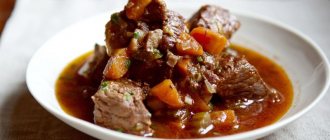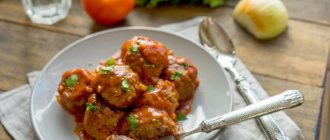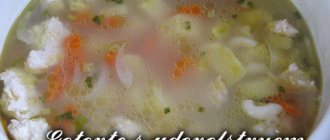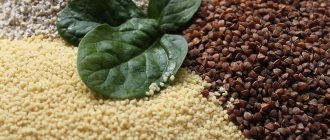Every mother knows that an infant up to one year old needs proper nutrition; he must receive a sufficient amount of vitamins, minerals, nutrients and trace elements.
Breast milk is, of course, good, but for a baby, starting from 6 months, it becomes not enough. Therefore, from this age it is necessary to introduce an infant to vegetables and fruits in the form of puree, cottage cheese, porridges from various cereals, meat and fish dishes. They most fully meet the needs of children in the second half of life.
Today, many young mothers, despite the variety of industrial - canned - food for children, prefer natural products. That is, they find recipes for children under one year old and prepare them themselves.
Potato and zucchini puree
For cooking you will need: 100 gr. potatoes, 100 gr. zucchini, 40 gr. milk mixture, olive oil (half a teaspoon), egg yolk (half)
How to cook:
Rinse the potatoes and zucchini.
Remove the skin from the potatoes and remove all the seeds from the zucchini. Cut into small pieces. Place them in boiling water and boil for 20 minutes. Transfer the boiled ingredients into a blender and grind until pureed. Next, add the egg yolk, heated mixture and butter, and stir. The dish is ready.
You can also replace the zucchini with cauliflower. This delicious recipe for a 6 month old baby is suitable for both lunch and dinner.
Read - baby puree with zucchini: review of manufacturers.
Features of the menu for children up to one year old
The menu for a child under one year old has its own characteristics.
We recommend reading: What to feed a newborn baby
- Newborns and children up to 3-4 months are usually fed only breast milk or formula.
- The first to start receiving complementary feeding are 4-5 month old formula-fed babies and mixed-fed babies. As a rule, these are vegetable and fruit purees and porridges. Children who are fully breastfed begin to be fed no earlier than 6 months.
- From 6-7 months, the baby’s diet becomes more varied. His lunches and dinners will become “richer”: in addition to vegetable and fruit purees, he can be offered meat puree, some fermented milk products (curds), and cookies. The range of drinks is also expanding - juices, compotes, fruit drinks, children's tea, jelly.
- Fish, kefir, bread, and egg yolk are added to the diet of an 8-9 month old baby. For your information, many pediatricians recommend quail eggs rather than chicken eggs for children under one year of age. It has been proven that they are healthier and less likely to cause allergies (however, this problem still cannot be ruled out). Children of this age are offered only the yolk.
- Note! The baby still receives breast milk or formula at morning and evening feedings.
- 10-11 month old babies gradually wean from the breast. Offer your baby kefir instead of milk before bed. Now you can also add vermicelli to the menu of an almost one-year-old child.
And now, knowing the set of products that are allowed for babies at a certain period of their lives, you can create an individual menu for the baby (taking into account the characteristics of his body and, of course, taste preferences).
Dried apricot puree with rice
You will need: dried apricots (100 g), water (375 g), portioned rice porridge from the children's department of the supermarket in bags (2 tbsp), milk formula (80 ml).
How to cook:
We wash the dried fruit, place it in a pressure cooker and add water. Boil until softened, about 20 minutes. Transfer the boiled dried apricots to a mixer, add water and grind to puree. Mix the porridge and the heated mixture, and serve with 1 tablespoon of dried apricot puree.
A simple recipe for a six-month-old child for breakfast or afternoon snack.
Menu for a 6-month-old breastfed baby
As a rule, up to 6 months, babies who eat only mother's milk do not need complementary feeding. Only by the age of six months, the digestive system of babies is already able to digest foods other than breast milk. It’s not for nothing that the first teeth also erupt at this age - so that they can already acquire the skill of chewing food.
If your child has not yet received anything other than breast milk, then the first dishes for a 6-month-old child should be juices (mixtures of juices) or purees of fruits and vegetables. They should be given at lunchtime, immediately before breastfeeding. Gradually, as the baby grows, the lunch meal is completely freed from mother's milk.
The safest addition to breast milk is a simple mono-component puree. This could be apple puree, banana puree, carrot puree or mashed potato. When the baby’s stomach gets used to each of the products, you can give any combination of them. First cook the carrots and potatoes until soft and beat with a blender or grind through a sieve.
The next complementary food after puree can be milk porridge, porridge with vegetable broth or rice water.
Acceptable cereals: rice, oatmeal and buckwheat.
Milk buckwheat porridge
It’s easy to prepare porridge for a baby: first, boil buckwheat (1 tablespoon) washed in several waters with 50-70 ml of water, grind through a sieve and pour 100 ml of hot milk into a homogeneous mass and continue cooking for another 3-4 minutes.
It is better not to add sugar and salt yet.
Milk rice porridge with pumpkin
Cut the peeled pumpkin (100 g) into strips or cubes, add water just above the level of the pumpkin pieces and cook for 30 minutes. Add 1 tbsp. washed rice (can be replaced with buckwheat) and simmer together with the pumpkin for another 30 minutes.
We rub the cooked porridge through a sieve, add 2-3 tbsp. milk and bring to a boil. You can add half a tsp. butter
It is better not to use sugar and salt.
Carrot mousse with zucchini
You will need: carrots (120 gr.), zucchini (1 pc.), olive oil (1 tbsp.), honey (1/2 tsp.)
How to cook:
We wash and peel the vegetables, remove the seeds from the zucchini. Cut the peeled ingredients into small pieces.
Transfer the prepared products into the pressure cooker, add a little oil and leave to simmer, stirring regularly, for about 2 minutes. Then add 5 tablespoons of water, cover with a lid and leave to simmer over low heat for about 15 minutes until the ingredients soften.
Cool the vegetables, add honey and grind with an electric mixer to a mousse.
This recipe can be included in the children's menu in the “Desserts” section, as in another carrot dish for kids - “Apple and Carrot Casserole”.
Puree is the very first food for a newborn baby
The very first complementary food for newborns will be vegetable or fruit puree, so the proposed recipes can be used from 4-5 months of the baby’s life.
- Pumpkin with apple is a great option for breakfast, since this puree contains a large amount of vitamins. Pumpkin and apples should be thoroughly washed and the skin and seeds removed from the fruit. Fruits cut into small pieces are boiled in a small amount of water; you can cook the fruits in the microwave, this will save a lot of your time. When the pieces become soft and fragrant, they need to be crushed to a mushy state with a mixer or a regular fork; it is possible to dilute the puree a little with sugar syrup, but then it will need to be boiled for an additional few minutes.
- Cauliflower will become your baby's favorite dish if cooked correctly. You need to disassemble the cabbage into inflorescences, wash the cabbage thoroughly and remove any hard parts. Simmer the prepared pieces over low heat with the addition of a couple of tablespoons of boiled water. After boiling the fruits, rub the cabbage through a sieve or use a blender. You can add ½ of a hard-boiled chicken egg yolk and a few drops of good vegetable oil to the puree.
- Potatoes with herbs - involves the use of several ingredients to prepare the dish. Boil a couple of potatoes in lightly salted water, then cool and beat with 2 tablespoons of milk. If you use a blender for mixing, then greens (dill, parsley) can be added simply during the chopping process, and when using a masher, the green additives should be finely chopped with a knife.
- Assorted puree is prepared from a collection of various vegetables: potatoes, carrots, pumpkin, beets, and cabbage are suitable. All ingredients should be taken in equal proportions, but it is better to cook them separately to prevent the flavors from mixing. Boil vegetables in plenty of water, then cool slightly and peel. Now you need to mix everything with a blender. If the puree turns out to be too dense, it is permissible to add a little boiled milk. To avoid having to add salt to the puree, cook the vegetables in salted water.
Useful: 5 recipes for the most delicious pumpkin puree for babies
These recipes for children under one year old are also popular with older children, and they also go great with adults, since familiar foods served in an unusual form always seem tastier.
Pumpkin puree
For cooking you will need: pumpkin (200 gr.), milk mixture (125 ml.).
How to cook:
We carefully wash the pumpkin and remove the seeds, cut it into small cubes. Transfer it to a pressure cooker and cook until it softens. Then pour into a blender, add the mixture and grind to puree.
Store in the refrigerator for no longer than two days.
We can replace pumpkin with potatoes or avocado.
Menu for a 6-month-old bottle-fed baby
Dishes for a 6-month-old baby who eats dry milk formula become more varied. A bottle-fed baby needs additional nutrients more than an infant. Therefore, as a rule, additional dishes for infant formula are introduced earlier than for babies fed breast milk. Those. At this age, we only supplement the menu and fully provide lunch with vegetable soup with or without the addition of meat broth.
As an independent meal, children can already receive milk porridge or vegetable puree soup in full - 150 g + 20-30 ml of fruit juice or puree. For porridge, in addition to buckwheat, rice or oatmeal, you can take barley, corn and others. First, we carefully wash the cereal, then cook it in water, and season the finished porridge with the diluted milk mixture.
Formula-fed babies switch to meat-based soups and a more varied menu earlier than their infant-fed peers. They try meat and dairy products earlier. But it is very important to remember that new dishes for a 6-month-old baby are also introduced to the menu in very small portions, starting with half a teaspoon. We wish your baby to grow up healthy and energetic!
Pumpkin puree with pear
For preparation you need: butternut pumpkin (1 pc.), pear (1 pc.). Dish for 6 servings
How to cook:
We wash the pumpkin, divide it into two parts and remove the seeds. Cut the pumpkin into small pieces, place in a steamer and cook for about 15 minutes. We wash and remove the peel from the fruit, transfer it to a double boiler and continue cooking for another 5 minutes until the pumpkin softens. Move all the products into a blender, add water from the bottom of the steamer (about 6 tablespoons).
Butternut squash is hypoallergenic, so this recipe for a 6-month-old baby is also suitable for children with allergies. The pear can also be replaced with another fruit.
Read - Pear in baby's complementary feeding.
Complementary feeding options for lunchtime feeding
- Vegetables with rice: carrots, cauliflower, broccoli, parsley, stalked celery.
- Potatoes with carrots, zucchini, broccoli, beets, onions, celery.
- Porridges or soups with vegetable broth.
- Half a chicken yolk, which we mix with vegetable puree. We begin to add the yolk (boil hard-boiled eggs) with a small piece, carefully observing the reaction of the child’s body. Give the yolk no more than 2 times a week.
- After the child’s body gets used to vegetables, you can add 1 tsp to them. refined sunflower or olive oil. We also add the oil slowly, starting with a few drops.
- Starting from the age of 6.5 months, you can already introduce low-fat meat or chicken broth into the menu and prepare vegetable purees with it. Allowed meat: veal, rabbit and chicken. All purees are prepared using a second meat broth. The maximum volume of broth for feeding a 6-month-old baby is 30 ml.
Basic recommendations for mothers
- Give each new dish to your child in small portions once a day, carefully observing the reaction of the baby’s digestive system. Some children are prone to immediate manifestations of exudative diathesis, especially in response to red and orange vegetables or meat broth. Start with 1 tsp. food unfamiliar to the child, gradually (over the course of a week) increasing its volume to 150 g.
- Children under one year old should not be given cow's or goat's milk. Mammalian milk contains a high percentage of proteins and fats, and the baby’s kidneys may not be able to cope with such a load. Porridges and other dishes made with cow's milk can cause allergies and increase the risk of diabetes and anemia. Therefore, milk from infant formula is added to porridge.
Applesauce
To prepare you need: apple (150 g).
How to cook:
We wash the apple and remove the peel and core, cut it into small pieces. Boil until soft. Place the apple in a blender, add 1 tablespoon of water, and puree until smooth. The dish is ready.
Keep in the refrigerator for no more than two days. Another simple recipe for the children's menu.
Read - Apple in baby's complementary feeding.
Broccoli in cheese sauce
You will need: broccoli (100 gr.), butter (20 gr.), flour (20 gr.), milk (250 gr.), nutmeg (2 gr.), grated cheddar cheese (25 gr.), grated gruviere cheese (25 gr.).
How to cook:
Cut the broccoli into pieces and cook for about 8 minutes until softened.
To make the cheese sauce, melt the butter in a frying pan. Add flour to it until it forms a paste. Beat the resulting mass with a fork and add nuts little by little. A smooth white sauce should appear. Bring it to a boil and leave to cook for another 2 minutes. Remove the pan from the heat and stir in the cheese.
Place the broccoli on a plate and pour the resulting sauce on top.
The dish is ready.
If you are looking for what to cook for a six-month-old child, try this very exotic dish at least once!
On topic: Broccoli in complementary foods.
Cooking for childrenCollection, 2021
Mother's milk is the best food for a baby. An indisputable fact is that with breast milk the child receives not only all the vitamins and unique nutrients he needs, but also antibodies to fight various infections. According to the World Health Organization (WHO), breastfeeding forms a deeper psycho-emotional connection with the mother, promotes sensory and cognitive development, and protects the child from infectious and chronic diseases. Breast milk is a natural food product for newborns. It contains all the nutrients and energy a baby needs during the first months of life and continues to meet half or more of the baby's nutritional needs during the second half of the first year and one-third during the second year.
At the age of about 6 months, the baby begins to need additional nutrients, since breast milk is no longer able to provide all the needs of the growing body. This time, according to WHO recommendations, is most suitable for introducing complementary foods. Although mother's milk continues to be the main source of all substances important for life, the body no longer has enough energy, vitamins and microelements. By this time, the baby’s digestive system is physiologically ready to digest coarser foods. Moreover, its use becomes vital. Complementary foods cause the release of special enzymes that have a positive effect on the motility of the gastrointestinal tract.
But 6 months is the average age for introducing complementary foods to breastfed children. A bottle-fed baby should start receiving complementary foods earlier - at 4–4.5 months. However, children do not grow according to an exact pattern and each child is individual: one is ready for complementary feeding at 5 months, the other only at 9. It all depends on how the baby develops, whether he has enough breast milk, whether he is prone to allergic reactions and many other factors. Accurate information about whether the baby is ready for the introduction of complementary foods can only be given by a pediatrician who observes its development. In order to determine whether it’s time for your son or daughter to start giving complementary foods, you should pay attention to the following factors:
• the baby does not have enough breast milk: he is increasingly put to the breast;
• the baby sits confidently without support;
• the baby's weight has doubled since birth, and in premature babies - two and a half times;
• the child shows interest in food from the diet of the adults around him, looks at them with interest when they eat, tries to take food from the plate or from the mouth of the parents;
• the child's reflex of pushing food out with the tongue gradually fades. You can check this in a simple way: offer your baby water in a spoon, he must swallow it. This skill is very important so that complementary foods are completely digested.
Before introducing complementary foods, the child must be absolutely healthy. Malaise, fever, problems with the tummy or teeth are not the best companions for such an important, but unusual for a baby, process as introducing new food.
After determining the time to start complementary feeding, the next question becomes: where to start and how to do it correctly?
The first feeding is a very individual matter. The choice of dishes for him depends on the characteristics of the body and the condition of the baby. If you have a problem with weight loss, it is better to start with gluten-free cereals, in other cases - with vegetable and fruit purees.
At first, the dish should consist of one type of product; you should not mix two types of vegetables, fruits or berries in one puree or juice. The best foods for the first vegetable feeding are cauliflower and broccoli, potatoes and zucchini (especially if the baby has constipation). Colored fruits and vegetables (red apple, dark grapes, carrots, beets, pumpkin) are offered to the baby a little later. It is advisable not to add sugar to fruit purees and salt to vegetable purees.
The healthiest way to prepare vegetables is to steam them and then chop them using a blender or sieve. With this heat treatment, more vitamins and other useful substances are preserved. The puree must be made liquid, because the baby is not yet ready to swallow thick food.
Porridges for a 6-month-old baby are introduced, starting with one type of cereal. It is recommended to prepare gluten-free porridges: buckwheat, rice and corn. First you need to sort out the cereal, grind it in a coffee grinder and only then cook it. Both water and breast milk are suitable for cooking. It is useful to add melted butter to the finished porridge.
At the age of about 8 months, meat can be introduced into the baby’s diet. It is recommended to start complementary meat feeding with lean beef, or poultry (turkey), or rabbit - these are the most hypoallergenic and easily digestible types of meat. Since the baby cannot yet chew food well, meat dishes should be thoroughly ground to a smooth puree. To do this, the meat must be cleaned of veins and films, boiled well and finally minced twice through a meat grinder or chopped using a blender. Meat must be introduced into the child’s diet gradually: start with ¼ teaspoon and, gradually adding, bring it to the daily norm (30–50 g for an 8–12 month old child). Monitor your child carefully to see if he has an allergic reaction. At first, the meat can be added to vegetable puree, which is already familiar to the baby, or mixed with milk. Then it is recommended to try giving it separately. When cooking meat, as well as directly into meat puree, you do not need to add salt and spices. For each complementary food, only freshly prepared meat should be used. Since a child’s kidneys are not fully formed until they are one year old, under no circumstances should you give your baby meat broths. For soup, use vegetable broth.
Cottage cheese and kefir - a source of calcium and phosphorus, which are so necessary for the formation of bone tissue - children first try at 7-8 months. Getting to know cottage cheese, which contains, among other things, B vitamins, niacin, and folic acid, starts with ½ teaspoon. Within a month, the daily volume of consumption should be increased to 30–40 g. Keep in mind that even by the end of the first year of life, the volume of cottage cheese in the baby’s daily diet should not exceed 50 g! The baby's kidneys may not be able to handle larger amounts of this product due to its high protein content. Kefir should be introduced into children's diets gradually, starting with 30 ml, increasing the volume of product consumed to 200 ml by 9 months, which corresponds to the volume of one feeding. When choosing kefir, carefully read the labeling to see if it is intended for children. Fermented milk products for children have a delicate taste and low acidity. The composition of regular kefir does not meet the physiological needs of a child in the first year of life, so the baby must be fed with kefir created specifically for baby food.
Fish, rich in proteins, omega-3 fatty acids, vitamins, fluorine and phosphorus, can be given to a child after 9 months. For baby food, it is recommended to use predominantly low-fat varieties of fish (containing no more than 4% fat), but all types of fish with medium fat content are also acceptable in the children's diet. Low-fat varieties include cod, hake, river perch, navaga, pike perch, and flounder. Medium-fat varieties include sea bass, herring, trout, and sea crucian. Fish varieties such as herring, mackerel, salmon are fatty varieties and therefore are not recommended for use in baby food. You should give fish to your baby very carefully, because this product quite often causes allergies.
In general, the rules for introducing any complementary foods are as follows: each product is introduced starting with 1 teaspoon. The dosage is increased gradually over 5–7 days until the full dose is reached. The child himself will show that he is full by turning his head away, pushing away the spoon or refusing to open his mouth. Every time after the baby has received complementary foods, it is advisable to put it on the breast. This will help maintain lactation and the baby will feel satisfied.
If a child refuses complementary feeding, there is no need to force-feed him, as he may refuse all other foods altogether. You can offer a product that has a different taste or texture, or the same product on a different day. To make it easier for a child to get used to new tastes, it is recommended to add breast milk or formula in the case of artificial feeding to complementary feeding products.
Complementary foods should be freshly prepared, have a soft, homogeneous consistency ranging from creamy to creamy (depending on age), and be cooled to body temperature (36–37 °C).
Of course, it is necessary to feed your baby breast milk for as long as possible. It remains the main food for up to a year, a source of growth hormones and antibodies that form the child’s immunity. But remember that the main task of complementary feeding is to awaken food interest and form the baby’s natural eating behavior: the development of the chewing apparatus, stimulating the enzyme system of the gastrointestinal tract to digest “adult” food. Therefore, do not make it a goal in itself to maintain portion sizes or alternate types of food. Be guided by your child's tastes and be patient if getting used to solid foods is a little difficult.
Pasta with zucchini and corn
For the dish you will need: butter (20 gr.), tomato (1 pc.), zucchini (1 pc.), small pasta (60 gr.), corn (2 tbsp.). 500 ml dish.
How to cook:
Wash the zucchini and tomato, peel and cut into small pieces or grate. Melt the butter in a deep frying pan and add vegetables there. Stir until they soften.
Boil the pasta in a pressure cooker, drain the water and transfer it to a small plate, adding fried vegetables and corn to it.
Keep in the refrigerator for no longer than two days. This is a dinner for a 6 month old baby.
Meat dishes for little gourmets
From 7-8 months, meat is introduced into the diet of babies, so from this moment on, the menu of newborns should include meat purees, pates and cutlets every day.
- A tasty and tender meat puree can be made from chicken or rabbit. We wash the fresh meat well under running water, cut it into small pieces and place it in a saucepan, fill it with water so that it covers it completely, and set it to cook over high heat. After boiling, reduce the power of the stove and continue to simmer until done under a closed lid. When the water has almost boiled away, the meat should be taken out and passed through a meat grinder, and then rubbed through a sieve. You should end up with a rather dry mass, so it should be diluted with the meat broth in which the meat was cooked; in addition, you can add a piece of butter.
- Chicken soufflé is made from fresh minced chicken without any additives, mixed with raw chicken yolk. The resulting mass should be placed in a greased frying pan and baked in the oven until a light crust is obtained. This dish for children turns out well in the microwave; the cooking time depends on the selected oven power.
- Liver puree will be a good addition to meat and fish dishes; it goes well with any puree, and can also be used as a pate. Beef or chicken liver must be thoroughly washed, the streaks of bile removed and simmered a little in a saucepan under a closed lid (to prevent the liver from burning, it is recommended to add water to the vessel). Grind the cooled pieces with a mixer, then dilute with warm milk and boil for 5 minutes. Butter will help emphasize the delicate taste of the milk liver.
- Even picky little ones will like fish cutlets. Children can be offered low-fat varieties of fish, for example, cod, hake, pollock (it is better to choose fish without small bones, it is easier to work with). The fish should be cleaned of skin and bones, then rinsed and minced through a meat grinder along with a crumb of white bread, diluted with egg yolk and a little salt. The resulting minced meat should be thoroughly mixed and formed into small balls. The cutlets are placed in a deep bowl, filled with water or milk and simmered over low heat for 20-25 minutes, in a double boiler for 10-15 minutes.
Useful: What fruits can a nursing mother eat?
During the cooking process, you can slightly change the proposed recipes for children and add other components to them. For example, a delicious soufflé will turn out not only from chicken, you can take lean pork or rabbit, however, such a dish will take a little longer to prepare, etc.
Vegetable puree
Ingredients: potatoes (1 pc.), carrots (1 pc.), zucchini (1 pc.). 500 ml dish.
How to cook:
We carefully wash the vegetables, peel them and cut them into large pieces. Place in a pressure cooker and cook until soft.
Transfer them to a mixer and grind until pureed.
The dish is ready.
Keep in the refrigerator for no more than two days. You can also use beans.
Read: Vegetables on a child’s menu.
Recipes for delicious dishes for babies up to one year old
Feeding your little one is tasty and healthy! Below we present to your attention simple recipes for dishes for babies up to one year old, tested by many mothers.
Rice porridge with pumpkin
Cereal dishes (porridge) contain many useful substances, vitamins and minerals that children need for the proper formation of their digestive tract. Porridge is usually served for breakfast, but it is also suitable for dinner.
Required Products:
- Short grain rice - 30 g;
- milk + water - 300 ml;
- pumpkin - 50 g;
- butter;
- salt;
- sugar (partial teaspoon).
Rice porridge with pumpkin is a wonderful breakfast for a baby. It is very easy to prepare, and all children, without exception, like it.
How to cook:
- The cereal must be washed under cold running water.
- Bring 150 ml of water to a boil and add diced pumpkin to it. Pumpkin can be fresh or frozen. Boil it for 5 minutes, cook until almost done. Then put it on a plate.
- Add rice cereal to the resulting vegetable broth. Cook for 5-10 minutes after boiling.
- Add milk, stir and bring to a boil, then cook for 10-15 minutes.
- Lay out the pumpkin. Add sugar and a little salt.
Oatmeal casserole with apple
Casseroles are the perfect breakfast and dinner for newborns. Prepared with love by a caring mother, they will become a favorite treat for picky little ones.
Required Products:
- oat flakes No. 2 (medium or fine grind) - 4 tbsp. l.;
- milk - 150 ml;
- sugar - ½-1 tsp. l.;
- egg - 1 pc.;
- apple - half.
Prepare your baby an oatmeal casserole with an apple for breakfast - even the most picky people will not be able to deny themselves the pleasure of enjoying this dish
How to cook:
- Cook thick oatmeal. To do this, add oatmeal to boiling milk and cook for 5 minutes under the lid. Add sugar. Remove from the stove and cool.
- Cut the apple into small cubes (it is better to remove the peel).
- Place the apple cubes in the porridge and mix.
- Mix the egg yolk into the cooled oatmeal-apple mixture, and then add the white, previously whipped in a blender until foamy. The protein will make the casserole tender.
- Grease the baking dish with butter and sprinkle the walls with semolina so that the casserole can be easily removed.
- Place in the oven at 180° for 30 minutes.
- The dish needs to be cooled and cut into portions.
Fish soup with rice and potatoes
Soups for children under one year of age are a very important dish, so do not exclude it from the children's diet; offer your child a healthy soup for lunch. Fluid is needed for the proper formation of the newborn’s gastrointestinal tract.
Required Products:
- cod –100 g (or any other white fish - hake, pollock. These fish contain the least protein, to which children are allergic);
- potatoes – 1 pc.;
- carrots – ¼ pcs.;
- onion – ¼ pcs.;
- rice - 2 tbsp. l.;
- salt (to taste).
Fish is a very healthy product, but for children under one year old you need to be careful with it. It is introduced only at the age of 8-9 months of the child’s life, and the fish soup is cooked in secondary broth. This will help reduce the amount of allergens found in the protein.
How to cook:
- We wash the fish and put it in a pan with 600 ml of water (you will get 2 servings). Bring to a boil.
- Cut the peeled potatoes into small cubes, grate the carrots, and chop the onion. For six-month-old babies, the soup will still have to be pureed, so in this case it doesn’t matter how you cut it.
- After the broth boils, be sure to skim off the foam. This is protein. Vegetables are added next.
- When the soup boils, add the rice.
- Cover with a lid and cook the soup until done.
Please note: we do not sauté vegetables or fry them for children's soup. We don't add pepper either.
Advice: when feeding this soup for the first time, it should be cooked in secondary broth, since the protein concentration in this case decreases, which means the risk of allergies is reduced. Potatoes should also be pre-soaked in water to remove excess starch.
Steamed chicken meatballs
Meat is a necessary product in the diet of a little person. If you introduced meat in the form of purees into complementary foods at 6 months, then by 8-9 months you can prepare this product in the form of souffles and meatballs.
Required Products:
- chicken fillet - 150 g;
- vegetables at your discretion: you can take 20-30 g of broccoli, cauliflower, carrots, onions;
- sour cream - 1 tsp. l.;
- semolina - 1/3 parts l.;
- salt.
Make meatballs for your little one for lunch. The side dish can be vermicelli or vegetables
How to cook:
- Cut the chicken into smaller pieces and place in a blender.
- We also put the vegetables there, after chopping them. If they are frozen, they should be boiled first.
- Grind everything until minced.
- Add sour cream to the resulting minced meat, which will give the meatballs softness, and semolina.
- With hands dipped in water, form small balls and place them in a steamer, multicooker (in a bowl for steaming) or in a manty dish. Cooking time: 30 minutes.
- Decorate the top of the meatballs with a sprig of dill and add a spoonful of sour cream.
- You can serve chicken meatballs with a vegetable side dish or noodles (by 10-11 months).
Classic apple compote
6 and 7 month old babies can drink a delicious compote made from fresh fruits, berries and dried fruits. Compotes are sources of vitamins, so it is very good to cook them in autumn and winter to strengthen the immune system.
Advice: it is recommended to give the compote warm to the child after meals, since cold drinks, as studies by radiologists have proven, interfere with the digestion of food.
Required Products:
- apple - 1 pc.,
- water - half a liter.
Compote is not only a tasty drink, but also very healthy: it strengthens the immune system and removes harmful substances from the body.
How to cook:
- Chop the apple and throw it into the saucepan. To fill with water.
- Bring to a boil and immediately remove from heat. Let it brew for 1 hour.
Tips: Do not remove the lid from the pan during this hour. If you want compote with pulp, just beat it with a mixer or blender.









